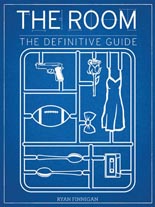 Oh hai! Ryan Finnigan’s The Room: The Definitive Guide tears me apart as I try to determine just whom it is for: virgins or sluts? On one hand, much of the Applause trade paperback is geared toward the newbie; on the other, the train wreck of a drama it celebrates is one of those flicks for which the phrase “must be seen to be believed” was coined. And unless you’ve seen Tommy Wiseau’s The Room, you cannot, will not “get it,” making guest Alan Jones’ beat-by-beat plot rehash superfluous on at least two levels. The Guide is most enjoyable in its Q-and-A interviews with the principal players, and most insufferable in its “how to” articles on audience participation and overall indoctrination. Special attention must be given to the colorful, dot-patterned infographics that appear throughout, encapsulating those unmistakable Wiseau vibes in a way that mere words fail.
Oh hai! Ryan Finnigan’s The Room: The Definitive Guide tears me apart as I try to determine just whom it is for: virgins or sluts? On one hand, much of the Applause trade paperback is geared toward the newbie; on the other, the train wreck of a drama it celebrates is one of those flicks for which the phrase “must be seen to be believed” was coined. And unless you’ve seen Tommy Wiseau’s The Room, you cannot, will not “get it,” making guest Alan Jones’ beat-by-beat plot rehash superfluous on at least two levels. The Guide is most enjoyable in its Q-and-A interviews with the principal players, and most insufferable in its “how to” articles on audience participation and overall indoctrination. Special attention must be given to the colorful, dot-patterned infographics that appear throughout, encapsulating those unmistakable Wiseau vibes in a way that mere words fail.
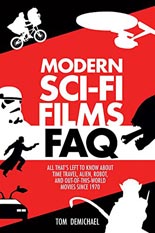 Also from Applause is the latest in its crash-course FAQ series, Modern Sci-Fi Films FAQ: All That’s Left to Know About Time Travel, Alien, Robot, and Out-of-This-World Movies Since 1970. Better than James Bond FAQ, author Tom DeMichael’s previous contribution to the franchise, this book pays tribute to the genre’s literary greats (and, um, Stephenie Meyer?!?) before jumping into a thematic trip through contemporary flicks of future visions, galactic travels, ripples in time and robots amok. Readers are likely to have heard of all DeMichael’s choices, if not seen them all, too: Star Wars, Alien, Robocop, E.T., et al. Any disappointment stemming from the trade paperback is not that the contents are heavy with such megabudgeted crowd-pleasers, but that so much of said contents is spent summarizing those movies’ stories, from frame one to fade-out, spoilers be damned. The afterwords to each picture favor information of the trivial kind, whereas the critical might whet more appetites. Recommended to sci-minded kids who aren’t sure what titles to add their Netflix queue, but skippable for any moviegoer old enough to gain admission to R-rated fare.
Also from Applause is the latest in its crash-course FAQ series, Modern Sci-Fi Films FAQ: All That’s Left to Know About Time Travel, Alien, Robot, and Out-of-This-World Movies Since 1970. Better than James Bond FAQ, author Tom DeMichael’s previous contribution to the franchise, this book pays tribute to the genre’s literary greats (and, um, Stephenie Meyer?!?) before jumping into a thematic trip through contemporary flicks of future visions, galactic travels, ripples in time and robots amok. Readers are likely to have heard of all DeMichael’s choices, if not seen them all, too: Star Wars, Alien, Robocop, E.T., et al. Any disappointment stemming from the trade paperback is not that the contents are heavy with such megabudgeted crowd-pleasers, but that so much of said contents is spent summarizing those movies’ stories, from frame one to fade-out, spoilers be damned. The afterwords to each picture favor information of the trivial kind, whereas the critical might whet more appetites. Recommended to sci-minded kids who aren’t sure what titles to add their Netflix queue, but skippable for any moviegoer old enough to gain admission to R-rated fare.
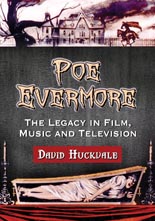 Fresh off a book on Hammer Films’ Psychological Thrillers for McFarland & Company, David Huckvale keeps things eerie with Poe Evermore: The Legacy in Film, Music and Television. Hardly the publisher’s first foray into all things Poe, the paperback serves as proof — not that any was needed — that the works of ol’ Edgar Allan have worked their way into our collective pop-culture consciousness like vines to trees. Taking an alphabetical trip through the master’s complete works, Huckvale discusses both direct adaptations to screen and pervasive influences on other people’s works. While some of the latter could be considered a stretch — one could argue TV’s Six Million Dollar Man probably would have existed Poe or no — Evermore works best as a reference guide to the continuing omnipresence of the horror and mystery forefather’s ghoulishly Gothic tales, characters and themes.
Fresh off a book on Hammer Films’ Psychological Thrillers for McFarland & Company, David Huckvale keeps things eerie with Poe Evermore: The Legacy in Film, Music and Television. Hardly the publisher’s first foray into all things Poe, the paperback serves as proof — not that any was needed — that the works of ol’ Edgar Allan have worked their way into our collective pop-culture consciousness like vines to trees. Taking an alphabetical trip through the master’s complete works, Huckvale discusses both direct adaptations to screen and pervasive influences on other people’s works. While some of the latter could be considered a stretch — one could argue TV’s Six Million Dollar Man probably would have existed Poe or no — Evermore works best as a reference guide to the continuing omnipresence of the horror and mystery forefather’s ghoulishly Gothic tales, characters and themes.
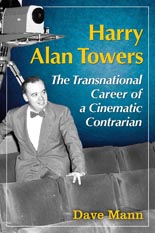 I learned much, much more about one of the filmdom’s most notorious B-movie producers from Dave Mann’s Harry Alan Towers: The Transnational Career of a Cinematic Contrarian than from Towers’ own autobiography, Mr. Towers of London, brought out last year by Bear Manor Media. For starters, Mann’s work — published by McFarland — works with nearly 100 more pages; for another, Mann’s all depth vs. Towers’ more surface-skidding approach. It also gives the subject his due in pioneering production methods; the man never met a tax threshold he could not, would not, did not exploit. In fact, it’s suggested that cult director Jess Franco’s now-trademark zooms are a result of Towers’ crank-’em-out insistence. From humble beginnings to Fu Manchu adventures to late-’80s Cannon fodder (including threequels of the mighty Delta Force and American Ninja franchises), each phase of Towers’ career is covered with a scholar’s eye for detail, yet also a willingness to call a spade a spade — and by that, I mean Towers’ shortcomings in quality control: “relentless stichomythia being interspersed with ripe morsels of thickly cut ham.” Cult cineasts will find much of the salty meat ready to carve.
I learned much, much more about one of the filmdom’s most notorious B-movie producers from Dave Mann’s Harry Alan Towers: The Transnational Career of a Cinematic Contrarian than from Towers’ own autobiography, Mr. Towers of London, brought out last year by Bear Manor Media. For starters, Mann’s work — published by McFarland — works with nearly 100 more pages; for another, Mann’s all depth vs. Towers’ more surface-skidding approach. It also gives the subject his due in pioneering production methods; the man never met a tax threshold he could not, would not, did not exploit. In fact, it’s suggested that cult director Jess Franco’s now-trademark zooms are a result of Towers’ crank-’em-out insistence. From humble beginnings to Fu Manchu adventures to late-’80s Cannon fodder (including threequels of the mighty Delta Force and American Ninja franchises), each phase of Towers’ career is covered with a scholar’s eye for detail, yet also a willingness to call a spade a spade — and by that, I mean Towers’ shortcomings in quality control: “relentless stichomythia being interspersed with ripe morsels of thickly cut ham.” Cult cineasts will find much of the salty meat ready to carve.
 Finally, McFarland casts the spotlight on another man whose name is treasured among lovers of B film, in Larry Cohen: The Radical Allegories of an Independent Filmmaker. Now available in a paperback edition updated since the 1996 hardcover, Tony Williams’ work casts a probing, critical eye at the entire career of the underrated underdog — a scrappy, sardonic auteur who brings class to what otherwise may be crap (It’s Alive, Q: The Winged Serpent, The Stuff and so on) and who, on occasional, simultaneously penetrates and tweaks the mainstream with a swift script (Cellular and Phone Booth) of admirable calculation. Containing interviews with the man himself and seemingly no stone unturned (as Cohen’s work in TV and the stage get equal time), the book is a must for the faithful. Ill-advised drinking game: Take a shot every time Williams describes Cohen’s technique as “comic-strip”; you will die. —Rod Lott
Finally, McFarland casts the spotlight on another man whose name is treasured among lovers of B film, in Larry Cohen: The Radical Allegories of an Independent Filmmaker. Now available in a paperback edition updated since the 1996 hardcover, Tony Williams’ work casts a probing, critical eye at the entire career of the underrated underdog — a scrappy, sardonic auteur who brings class to what otherwise may be crap (It’s Alive, Q: The Winged Serpent, The Stuff and so on) and who, on occasional, simultaneously penetrates and tweaks the mainstream with a swift script (Cellular and Phone Booth) of admirable calculation. Containing interviews with the man himself and seemingly no stone unturned (as Cohen’s work in TV and the stage get equal time), the book is a must for the faithful. Ill-advised drinking game: Take a shot every time Williams describes Cohen’s technique as “comic-strip”; you will die. —Rod Lott
Buy them at Amazon.

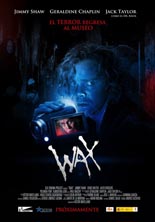 Spanish filmmaker Víctor Matellano’s Wax bears more similarity to 1953’s classic House of Wax than 2005’s official remake. With one foot planted firmly in horror cinema’s past, Matellano uses his other to sidestep between the decidedly more contemporary subgenres of found footage and torture porn. There’s room for all — perhaps even too much, as not enough time is allocated to each or any.
Spanish filmmaker Víctor Matellano’s Wax bears more similarity to 1953’s classic House of Wax than 2005’s official remake. With one foot planted firmly in horror cinema’s past, Matellano uses his other to sidestep between the decidedly more contemporary subgenres of found footage and torture porn. There’s room for all — perhaps even too much, as not enough time is allocated to each or any.  Mike’s still grieving over the murder of his wife and child by kidnapper-cum-cannibal Dr. Knox (Jack Taylor, Succubus) a year prior and — wouldn’t you know it? — the sinister senior surgeon lurks and stalks the halls after hours. In the basement is where the old man carries out his acts of Hostel behavior on his victims (most of them bare-breasted young women), keeping them sedated just enough for them to withstand the pain of being eaten alive as they watch.
Mike’s still grieving over the murder of his wife and child by kidnapper-cum-cannibal Dr. Knox (Jack Taylor, Succubus) a year prior and — wouldn’t you know it? — the sinister senior surgeon lurks and stalks the halls after hours. In the basement is where the old man carries out his acts of Hostel behavior on his victims (most of them bare-breasted young women), keeping them sedated just enough for them to withstand the pain of being eaten alive as they watch. 

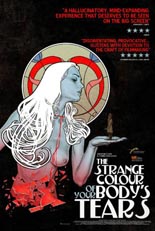
 Round and round goes the camera of Hélène Cattet and Bruno Forzani in
Round and round goes the camera of Hélène Cattet and Bruno Forzani in 






 Given the innocuous title and a cover to nearly match, I assumed Nathaniel Tolle’s
Given the innocuous title and a cover to nearly match, I assumed Nathaniel Tolle’s